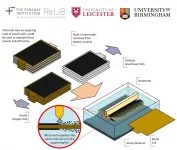(Press-News.org) A stimulating environment keeps the "hippocampus" - which is the brain's memory control center - young, so to speak. Causes of this are molecular mechanisms that affect gene regulation. These current findings from studies in mice provide clues as to why an active, varied life can help preserve mental fitness in old age. Researchers from the DZNE and the Center for Regenerative Therapies Dresden (CRTD) at the Technische Universität Dresden report on this in the journal Nature Communications.
Human DNA - and this also applies to mice - contains thousands of genes. However, it is not only the genetic blueprint that is decisive for the function of a cell and whether it is healthy or not, but above all which genes can be switched on or off. Aging, living conditions and behavior are known to influence this ability to activate genes. The phenomenon, referred to as "epigenetics", was the focus of the current study. For this, researchers including Dr. Sara Zocher and Prof. Gerd Kempermann examined mice that had grown up in different environments: One group of animals experienced, from a young age, an "enriched" environment with toys and tunnel tubes. The rodents of a second group did not have such occupational opportunities.
Attachments to the DNA
When the scientists examined the genome, they found that in those mice that grew up in the stimulating environment, there was, with age, only a relatively small change in certain chemical tags of the DNA. In mice from the low-stimulus environment, these changes were much more pronounced - in comparison between young and older animals. "We registered so-called methyl groups, which stick to the DNA," explains Gerd Kempermann, speaker for the DZNE's Dresden site, DZNE research group leader and also a scientist at the CRTD. "These chemical attachments do not alter the genetic information per se. Rather, they influence whether individual genes can be activated or not."
Malleable Brains
Such "epigenetic markings" tend to diminish with age, but in the animals with stimulating living conditions, the decrease in methyl groups was comparatively small. Thus, in old mice raised in a varied environment, gene activity had, in a sense, remained young. In particular, this affected a series of genes relevant to growing new neurons and cellular connections in the hippocampus. "Epigenetically, these animals retained a younger hippocampus," Kempermann says. Therefore, the brains of these mice were more malleable - experts speak of greater "neuroplasticity" - than in conspecifics of the same age that had grown up in a low-stimulus environment.
The current study did not include behavioral experiments. However, Kempermann points out that many other studies have shown that mice raised in high-stimulus settings perform better on memory tests than those from low-stimulus environments. "It is fair to assume that this mental fitness is due to the stabilization of methylation patterns that we observed," the neuroscientist says. "Of course, the question is to what extent our findings also apply to humans. Here, the situation is likely to be more complicated. After all, it is about how living conditions influence behavior and the way humans react to external stimuli is much more complex than in mice. However, we have good reasons to believe that the basic epigenetic principles are the same in humans as in mice."
INFORMATION:
Original Publication
Environmental enrichment preserves a young DNA methylation landscape in the aged mouse hippocampus, Zocher et al., Nature Communications (2021), DOI: 10.1038/s41467-021-23993-1; URL: https://doi.org/10.1038/s41467-021-23993-1 & https://rdcu.be/cm3nD
About Deutsches Zentrum für Neurodegenerative Erkrankungen, DZNE
(German Center for Neurodegenerative Diseases)
The DZNE is a research center that addresses all aspects of neurodegenerative diseases (such as Alzheimer's, Parkinson's and Amyotrophic lateral sclerosis) in order to develop novel approaches of prevention, treatment, and health care. It is comprised of ten sites across Germany and cooperates closely with universities, university hospitals, and other research institutions on a national and international level. The DZNE is publicly funded and a member of the Helmholtz Association of German Research Centers. Website: http://www.dzne.de/en
About the Center for Regenerative Therapies Dresden (CRTD)
The Center for Regenerative Therapies Dresden (CRTD) of TU Dresden is academic home for scientists from more than 30 nations. Their mission is to discover the principles of cell and tissue regeneration and leveraging this for recognition, treatment and reversal of diseases. The CRTD links the bench to the clinic, scientists to clinicians to pool expertise in stem cells, developmental biology, gene-editing and regeneration towards innovative therapies for neurodegenerative diseases such as Alzheimer's and Parkinson's disease, hematological diseases such as leukemia, metabolic diseases such as diabetes, retina and bone diseases.
Since 2016 the CRTD is part of the central scientific unit "Center for Molecular and Cellular Bioengineering" (CMCB) of the TU Dresden and plays a central role within the research priority area Health Sciences, Biomedicine, and Bioengineering of the TU Dresden.
Web: http://www.tu-dresden.de/cmcb/crtd
Web: http://www.tu-dresden.de/cmcb
FECYT - Spanish Foundation for Science and Technology - presented today at the headquarters of the National Museum of Science and Technology, MUNCYT, IN Alcobendas, the results of the third Social Perception Survey of scientific aspects of the COVID-19 in a debate moderated by Pampa García Molina, Editor-in-Chief of the SINC Agency, in which Raquel Yotti, Director of the Carlos III Health Institute of Madrid, Josep Lobera, Professor of Sociology at the Universidad Autónoma de Madrid (UAM) and scientific director of the Social Perception Survey on the scientific aspects of COVID-19 and ...
Polymers are long, chain-like molecules which are everywhere in biology. DNA and RNA are polymers formed by many consecutive copies of nucleotides coupled together. When being transported within or between cells, these biological polymers must pass through nanometre-sized holes called "nanopores".
This process also underlies a rapidly developing method for analysing and sequencing DNA called nanopore sensing.
The study, published in the journal END ...
Researchers at the University of Leicester have developed a new method to recycle electric vehicle batteries using a ground-breaking new approach that many will have experienced in the dentist's chair.
The Faraday Institution project on the recycling of lithium-ion batteries (ReLiB) led by Professor Andy Abbott at the University of Leicester used a new method, involving ultrasonic waves, to solve a critical challenge: how to separate out valuable materials from electrodes so that the materials can be fully recovered from batteries at the end of their life.
Current recycling ...
A new corona test developed at the University Hospital Bonn can analyze a large number of swabs simultaneously using sequencing technology and has a similarly high sensitivity as the common qPCR test. The innovative method offers great potential, especially for systematic testing in daycare centers, schools or companies. Today, the results of the study on the new Corona test have been published in the renowned journal "Nature Biotechnology".
Bonn, 6/29/2021 - In addition to vaccination, systematic testing of the population remains of central importance in order to effectively monitor and contain the spread of infections during the Coronavirus pandemic. Only in this way can the spread of the virus be effectively monitored and ...
Crystallization is one of the most fundamental processes found in nature - and it's what gives minerals, gems, metals, and even proteins their structure.
In the past couple of decades, scientists have tried to uncover how natural crystals self-assemble and grow - and their pioneering work has led to some exciting new technologies - from the quantum dots behind colorful QLED TV displays, to peptoids, a protein-mimic that has inspired dozens of biotech breakthroughs.
Now, a research team led by scientists at the Department of Energy's Lawrence Berkeley National Laboratory (Berkeley Lab) and UC Berkeley has developed a nanoparticle composite that grows ...
The electronic properties of graphene can be specifically modified by stretching the material evenly, say researchers at the University of Basel. These results open the door to the development of new types of electronic components.
Graphene consists of a single layer of carbon atoms arranged in a hexagonal lattice. The material is very flexible and has excellent electronic properties, making it attractive for numerous applications - electronic components in particular.
Researchers led by Professor Christian Schönenberger at the Swiss Nanoscience Institute and the Department of Physics at the University of Basel have now studied how the material's ...
Mineral resources from Chile are of great importance to Germany. According to statistics from the World Bank, thousands of tons of valuable minerals are imported from the South American country every year, including raw materials for lithium-ion batteries. But their extraction causes ecological and social problems: "The use of the limited freshwater resources in northern Chile for mining regularly fuels conflicts with the local population," says Professor Thomas Kohl from KIT's Institute of Applied Geosciences (AGW). "Northern Chile is one of the driest regions on earth, but has extensive geothermal resources. With a novel type of plant, it is not only possible to generate electricity in a climate-friendly way, but also to extract ...
When positioned strategically, garment seams sewn with conductive yarn can be used to accurately track body motion, according to computer scientists at the University of Bath in the UK. Best of all, these charged seams are able to respond to subtle movements that aren't picked up by popular fitness trackers, such as watches and wristbands.
In a new study, the Bath researchers found that clothing made with conductive seams can be analysed to identify the wearer's movements.
PhD student Olivia Ruston, who presented the work at the ACM Designing Interactive Systems conference this month, said: "There are lots of potential applications for conductive yarn in any activity where you want to identify and improve ...
Mice are an important animal model of human vision due to the powerful genetic tools available in this species. However, mouse vision was thought to be different to that of humans because humans have a region of the retina specialized for fine details called the 'fovea' whereas mice do not. Researchers from the Netherlands Institute of Neuroscience (NIN) have shown that the visual cortex of mice does contain a region of enhanced visual sensitivity dubbed the 'focea', making the mouse a better model of human vision than previously expected. The findings were published ...
Lithia, Florida -- June 29, 2021 -- Surgical resident training has traditionally occurred in a master-apprentice-type relationship, with graduated responsibilities until trainees are expected to perform procedures on their own. Given recent changes in the health care system, including reduced operating room time, increased difficulty of procedures and working hour restrictions, there is less time for residents to learn using traditional methods.
Researchers from the University of Manitoba and the Pan Am Clinic recently published a paper in the journal Arthroscopy, Sports Medicine, ...







